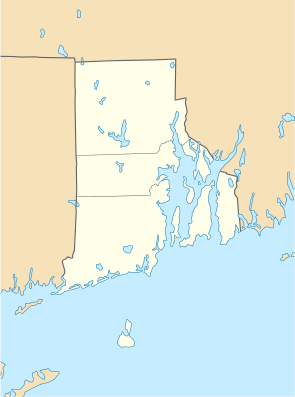Malbone Castle and Estate
|
Malbone | |
 | |
|
Malbone Castle | |
 | |
| Location | Newport, Rhode Island |
|---|---|
| Coordinates | 41°30′18.02″N 71°18′35.55″W / 41.5050056°N 71.3098750°WCoordinates: 41°30′18.02″N 71°18′35.55″W / 41.5050056°N 71.3098750°W |
| Built | 1849 |
| Architect | Davis,A.J.; Newton,Dudley |
| Architectural style | Gothic Revival |
| Governing body | Private |
| NRHP Reference # | 76000039[1] |
| Added to NRHP | October 22, 1976 |
Malbone is one of the oldest privately owned estates in Newport, Rhode Island. Located on Malbone Road, the estate has a history dating to the mid-18th century, but the present main was built in 1848-49. The estate once served as the country residence of Colonel Godfrey Malbone (1695–1768) of Virginia and Connecticut. Colonel Malbone made his fortune as a shipping merchant and slave trader, becoming one of the wealthiest men in Newport during the 1740s through privateering and the triangle trade. Malbone had built what Dr. Alexander Hamilton called one of the finest houses he had seen in the colonies, probably to a design by noted colonial architect Richard Munday.[2]
Future President George Washington boarded and dined at Malbone in February 1756 when he visited his good friend Col. Malbone. In 1766, during the course of a gala dinner party, a chimney fire[3] reduced the house to a pile of sandstone rubble. Reportedly Colonel Malbone, seeing no reason why the party should be interrupted, ordered dinner to be served outside, saying, "By God, if I have to lose my house, I shall not lose my dinner!"

A new house was built on this property, as the country villa of Mr. & Mrs. Jonathan Prescott Hall. Hall was an eminent New York lawyer and descendant of two signers of the Declaration of Independence. In May 1848, the Halls commissioned Alexander Jackson Davis, a notable 19th century New York architect, to design a house of pink sandstone with the ivy-covered ruin as its principal feature. The stone and brickwork before the front door is all that remains of the substantial country house built in 1741 by Malbone. Reconstruction was completed in 1849. The home remained in the same family for over 130 years and served as the summer residence of the Morris family, a prominent family from New York, who held positions of social and political prominence in America and Newport since the 18th century.
Malbone Estate had some of the foremost gardens in North America during the 18th and 19th centuries. Situated on 17 acres (6.9 ha) and designed between 1848–1850 by the architectural theorist Andrew Jackson Downing, a prominent advocate of the Gothic revival style, the gardens consisted of gravel and brick pathways with borders of boxwoods, and artificial fish ponds lined with cobblestone. The grounds also include the largest private collection of beech trees in the Northeast, and had terraces displaying marble and bronze sculpture, a park of fine specimen trees and a lavish lower garden featuring marble pavilions, fountains, a sunken garden, and carriage house and garage.
In 1978, Malbone was bequeathed to the Preservation Society of Newport County by the Morris family, and is now privately owned by the Brede Family of Wellesley, Massachusetts. The property was listed on the National Register of Historic Places in 1976.[1]

See also
References
- Gardens of Colony and State: Gardens and Gardeners of the American Colonies and of the Republic Before 1840 by Alice G. B. Lockwood.
- ↑ 1.0 1.1 "National Register Information System". National Register of Historic Places. National Park Service. 2007-01-23.
- ↑ "NRHP nomination for Malbone". Rhode Island Preservation. Retrieved 2014-11-05.
- ↑ "June 1766 fire, page 98". Retrieved 26 February 2014.
External links
- Historic American Buildings Survey (HABS) No. RI-340, "Malbone, Malbone Road, Newport, Newport County, RI", 14 photos, 10 data pages, 1 photo caption page
| ||||||||||||||||||||||||||